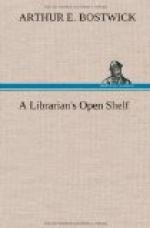DRUGS AND THE MAN
A Commencement address to the graduating
class of the School of
Pharmacy, St. Louis, May 19, 1915. (Journal
of the American
Pharmaceutical Association, August,
1915, p. 915-22)
HOW THE COMMUNITY EDUCATES ITSELF
Read before the American Library Association,
Asbury Park, N.J.,
June 27, 1916. (Library Journal,
August, 1916, p. 541-7)
CLUBWOMEN’S READING
(The Bookman, January-March, 1915,
p. 515-21, 642-7, 64-70)
BOOKS FOR TIRED EYES
(Yale Review, January, 1917, p.
358-68)
THE MAGIC CASEMENT
Read before the Town and Gown Club, St.
Louis.
A WORD TO BELIEVERS
Address at the closing section of the
Church School of Religious
Instruction.
INDEX
A LIBRARIAN’S OPEN SHELF
ESSAYS ON VARIOUS SUBJECTS
DO READERS READ?
Those who are interested in the proper use of our libraries are asking continually, “What do readers read?” and the tables of class-percentages in the annual reports of those institutions show that librarians are at least making an attempt to satisfy these queries. But a question that is still more fundamental and quite as vital is: Do readers read at all? This is not a paradox, but a common-sense question, as the following suggestive little incident will show. The librarian-in-charge of a crowded branch circulating-library in New York City had occasion to talk, not long ago, to one of her “star” borrowers, a youth who had taken out his two good books a week regularly for nearly a year and whom she had looked upon as a model—so much so that she had never thought it necessary to advise with him regarding his reading. In response to a question this lad made answer somewhat as follows: “Yes, ma’am, I’m doing pretty well with my reading. I think I should get on nicely if I could only once manage to read a book through; but somehow I can’t seem to do it.” This boy had actually taken to his home nearly a hundred books, returning each regularly and borrowing another, without reading to the end of a single one of them.
That this case is not isolated and abnormal, but is typical of the way in which a large class of readers treat books, there is, as we shall see, only too much reason to believe.
The facts are peculiarly hard to get at. At first sight there would seem to be no way to find out whether the books that our libraries circulate have been read through from cover to cover, or only half through, or not at all. To be sure, each borrower might be questioned on the subject as he returned his book, but this method, would be resented as inquisitorial, and after all there would be no certainty that the data so gathered were true. By counting the stamps on the library book-card or dating-slip we can tell




